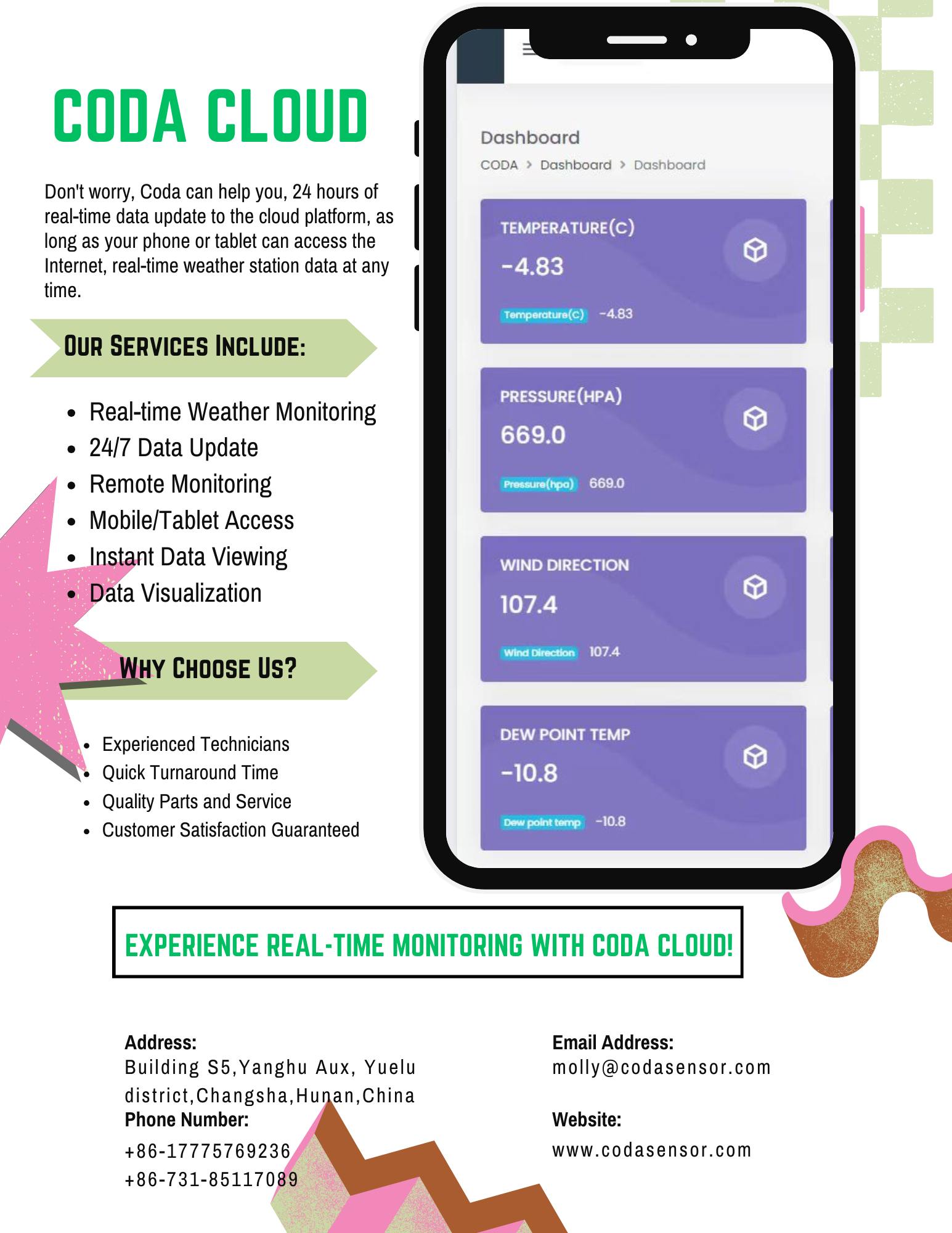In a world increasingly dependent on real-time data for decision-making, the integrity of environmental intelligence is paramount. The shift from manual checks to automated, continuous surveillance marks the rise of Smart Monitoring, with the Automatic Weather Station (AWS) serving as the essential nerve center.
For over a decade, CODA Sensor technology has been engineering the foundation of this revolution. We provide the precision instruments that transform complex environmental variables into reliable, actionable data streams, establishing a robust IoT infrastructure for a smarter, safer, and more efficient planet.
The performance of any Automatic Weather Station hinges on the quality of its components. CODA specializes in manufacturing highly accurate, industrial-grade Environmental Sensors designed for continuous operation in harsh conditions.
Our sensor suite is built on principles of low maintenance and high fidelity:
Wind Dynamics (CDF Series): Utilizing both robust carbon fiber three-cup designs (CDF-10A) and advanced Ultrasonic Wind Sensors (CDF-21A/22A), CODA ensures exceptional sensitivity and low starting thresholds. This precision is critical for applications like crane safety, where rapid, accurate gust detection is non-negotiable.
Solar Irradiance (CDG-10B Pyranometer): Our silicon-cell-based sensors offer a wide spectral range and excellent stability (e.g.,
Atmospheric Context (CDW-33A): A single, integrated sensor package for temperature, humidity, and pressure provides all necessary contextual data, simplifying installation and integration.
All Coda Sensors are designed for seamless integration: they feature low power consumption and versatile output protocols (RS485/Modbus, 4-20mA, etc.). This makes them ideal "edge devices" in an IoT network, ensuring stable data transmission even in remote, power-limited locations.
The AWS, exemplified by solutions like the CDF-26B Wind Recorder Station, acts as the physical-to-digital bridge. This Smart Monitoring process follows a critical closed-loop system:
Data Acquisition: Environmental Sensors measure parameters (wind, rain, irradiance).
Edge Processing: The central CODA data logger (like the CDH-TEA) collects the raw data, applies quality checks, and time-stamps the records, locally storing data for at least one year as a critical backup.
IoT Transmission: Data is pushed via robust communication modules (4G, Wi-Fi, or Ethernet) to a centralized server or cloud platform.
Actionable Intelligence: Cloud platforms use this real-time data to trigger automated responses, such as starting a pump, issuing a public alert, or recalibrating a solar tracker.
This complete IoT loop ensures operational efficiency and minimal latency in response to environmental changes.

CODA's Automatic Weather Stations are strategic assets that deliver measurable ROI across diverse sectors:
Benefit: Reduces resource waste and increases crop yield stability.
Example: In large-scale vineyards, an AWS combines Solar Irradiance data with humidity and wind speeds to calculate evapotranspiration. This Smart Monitoring ensures the irrigation system applies water only when the calculated moisture deficit reaches a specific threshold, reducing water consumption by up to 30% compared to timed irrigation schedules, directly lowering operating costs.
Benefit: Enhances public safety, reduces maintenance costs, and improves urban resilience.
Example: In a major port city, CDF-26B Wind Recorders are installed on all tall container cranes. The system is programmed to automatically send a pre-stow command and issue visual and audio alarms when the wind speed exceeds 50 km/h for more than 5 minutes. This prevents structural damage, avoids costly equipment downtime, and increases operational uptime safety compliance by 99%.
Benefit: Maximizes energy yield and ensures contractual compliance.
Example: Solar PV Monitoring relies heavily on CODA sensors. By using the CDG-10B Pyranometer and the PV Panel Temperature Sensor, operators can accurately calculate the Performance Ratio (PR). Identifying a persistent
The next evolution of Smart Monitoring integrates predictive capabilities:
AI-Driven Forecasting: Historical data collected by CODA Sensor systems feeds into Machine Learning models. These models move beyond simple status reporting to predictive maintenance, forecasting equipment failure based on thermal stress patterns or predicting localized weather anomalies hours in advance.
Edge Computing: Future CODA AWS units will process more complex algorithms directly at the sensor node, transmitting only analyzed insights (e.g., "Critical High Wind Event Imminent") rather than raw data. This reduces communication latency and enhances reliability in mission-critical applications.
By focusing on precision, reliability, and IoT integration, CODA Sensor technology continues to lead the industry, offering the definitive solution for organizations looking to leverage the power of environmental data.
Discover how real-time weather station data impr
Discover how Automatic Weather Stations (AWS) ar
Discover how CODA gas sensors are the invisible
Contact: Molly
Phone: +86-17775769236
Tel: 86-0731-85117089
Email: molly@codasensor.com
Add: Building S5, Aux Square, Yuelu District, Changsha City, Hunan Province, China
We chat